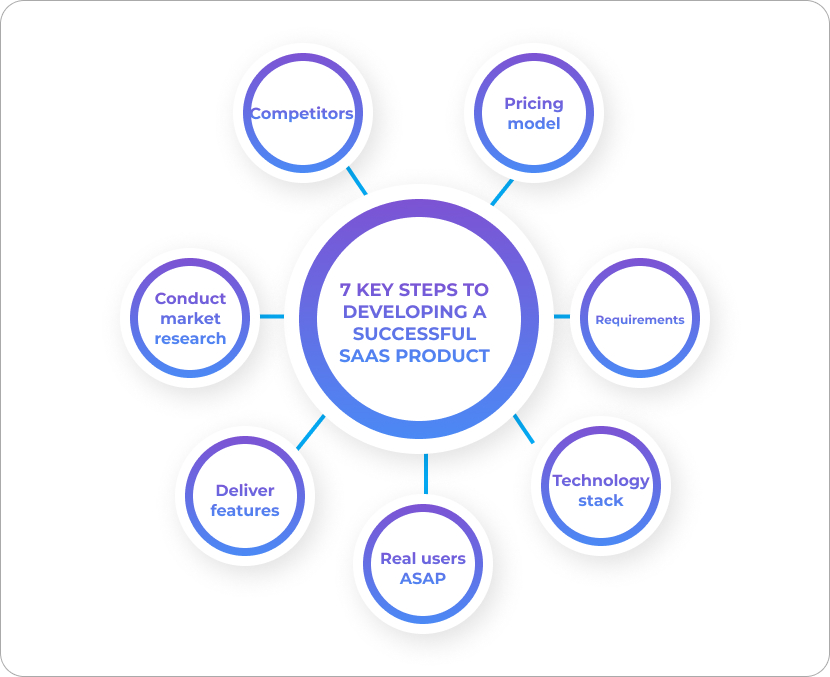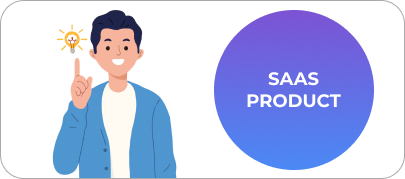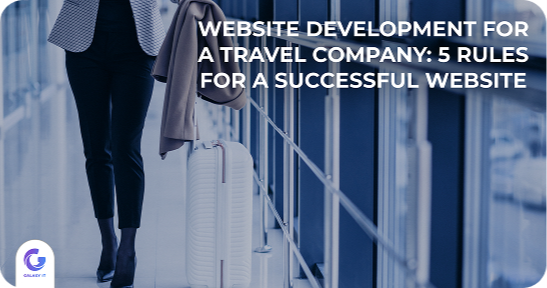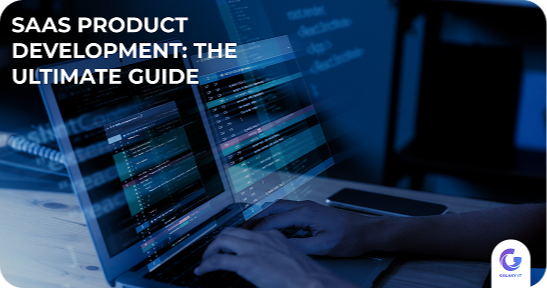7 Key Steps to Developing a Successful SaaS Product
- 08.07.2024
- 1 views
- 10 min
Businesses use SaaS products for various functions
Software as a Service (SaaS) has revolutionized software access in recent years. It is inherently scalable, user-friendly, and generally cost-effective. The industry is expanding rapidly, with Gartner reporting a 17.4% growth in 2022, reaching $154.6 billion.
Businesses use SaaS products for various functions, such as customer relationship management (CRM), project management, and human resources management. These products are utilized by startups, entrepreneurs, and organizations of all sizes.
The genesis of many SaaS applications often begins with someone identifying a problem, a gap, or a process inefficiency and thinking, "Wouldn't it be nice if...".
At first glance, it seems straightforward: identify a problem, understand the needs of those who share that problem, and start building a solution. It’s crucial to consider the end users’ needs and the specific problem your application will address.
While the journey from a great idea to a successful market entry may not always be linear, there are guiding principles in the SaaS product development process that can help you successfully launch a product. In this blog, we’ll explore 10 essential steps to set yourself up for success when building a SaaS product that meets market demand and generates substantial revenue for your business.
What is a SaaS product and Why is Needs in Your Business?
The simplest way to understand SaaS is that it’s an online software product accessible to all users via an internet connection. Most SaaS products are web and mobile apps that don’t require installation, and users pay a monthly or yearly fee to use the product. Unlike traditional software, SaaS users don’t need to download or install anything on their devices, as the application is hosted on a server provided by the company. Popular examples of SaaS companies include Dropbox and Google Apps.
A key component of a successful SaaS business model is thoroughly understanding your current and potential customers' needs. Accurately identifying the most valuable needs to address allows you to target them effectively in your product.
Key steps to building SaaS products successfully
Numerous SaaS products begin with promising ideas but encounter bumps and deviations in their roadmap that can affect a successful product launch. Conducting thorough market research, identifying potential customers, and devising a robust strategy are crucial steps before embarking on any coding. Here are 10 strategies to enhance your chances of success.

1. Conduct market research to implement your idea
Ensuring the long-term success of your product hinges on validating the existence of potential customers who will benefit from it. Is the problem your SaaS product aims to solve genuinely necessary for them? Is there a real demand and desire for your product among your target audience?
At Highland Research, this forms a significant part of our practice. We delve deeply to understand and identify your target audience or potential customers. It's crucial to ascertain whether your target customers are willing to pay for your product and if it effectively addresses their pressing needs. Create a prioritized list of these needs and objectively assess their significance in solving problems your product targets. Rather than relying solely on opinions, observe their behavior to uncover authentic insights. Consider how your product fits into their lives and the context in which they would use it. This blend of needs and context resembles a detailed user persona tailored specifically for new product research.
Conducting thorough market research and prototyping can preemptively avoid costly mistakes before committing to coding. Regardless of how evident the problem may seem, skipping this step risks assuming a market exists for your envisioned product that may not align with actual consumer motivations. This oversight can prove costly and detrimental to your product's success.
2. Study your competitors
Have you thoroughly examined your competitors in your industry? How are other companies addressing the same problem you've identified? Have you analyzed why users switch products to choose yours instead?
In the competitive SaaS market, understanding and learning from your competitors is crucial. Evaluate how your product compares to competitors and where it fits within the market landscape. At our organization, we utilize the Jobs to Be Done methodology to help companies understand the reasons behind customer decisions to either adopt or pass on their product. Typically, a successful new product strategy involves identifying a feature offered by a competitor and innovating to deliver it more effectively, meeting the needs of your user base.
3. Choose the right pricing model
What’s your pricing strategy for your product? As you develop your business plan, establish clear operational and financial objectives for your SaaS product launch. Include a structured and detailed framework for building your SaaS application and generating profits.
When it comes to the monetary strategy for your SaaS solution, there are various pricing models to consider:
- Usage-based pricing: Charging based on the amount of product usage.
- Pricing per feature: Offering different features that users can select and pay for.
- Freemium: Providing a free version with limited features, with options to upgrade to a paid version.
- Flat rate: Offering the entire product or a bundle of features at a single price, paid monthly or yearly.
- Pricing per user: Charging based on the number of users accessing the product.
How do you decide which model to implement? It all boils down to understanding the needs of your target users. Each pricing model has its advantages depending on the market segment you’re targeting and the value proposition of your product. Carefully assess what will resonate best with your customers and align with your business goals to determine the most suitable pricing strategy for your SaaS product.
4. Define your SaaS product development requirements
Instead of starting with a product that includes all possible features, begin with a basic set that fulfills the core purpose, emphasizing understanding user needs.
Define your Minimum Viable Product (MVP) by identifying the essential features that deliver value to your customers at minimal cost. Gather feedback from potential customers to validate your business idea and experiment with different approaches. With a well-crafted product roadmap from strategic planning and adherence to scope, you can focus on building a streamlined MVP.
Embrace new features that directly cater to your target users while resisting unnecessary functionalities that could detract from your goals. Early focus and discipline are key to bringing your product to market quickly with real users. Managing a SaaS project internally, especially with multiple stakeholders, can be challenging. Consider outsourcing SaaS design and development to external specialists who specialize in managing the entire lifecycle of SaaS products.
5. Choose the right features and technology stack
It’s crucial to define what sets your product apart from competitors. What is your Unique Value Proposition (UVP) for new customers? While SaaS products share common features, a clear plan outlining specific features, customization options, integration capabilities, and robust security measures is essential.

In a SaaS model, certain elements are paramount:
- Security: Given that SaaS involves storing end users' data in the cloud, robust security measures are critical to safeguard against cyber threats and vulnerabilities.
- User-friendliness: Your product should offer a seamless, intuitive user experience that empowers users and instills confidence in using your platform.
- Performance: Select a technology stack that supports scalability as user numbers and requirements expand over time.
Avoid falling into the trap of feature parity, where you add components simply because competitors offer them. Stay focused on meeting customer needs and preferences. Keep your target audience at the forefront and visualize their user journey through wireframes and prototypes.
Choosing the right technology stack is crucial, especially for native or hybrid mobile applications. Various technologies excel in different applications, and major cloud providers like Amazon, Google, and Microsoft offer accelerators and tools tailored to their environments. Prioritize speed during the initial build phase while making informed decisions that facilitate future scalability without unnecessary complexity.
6. Get your product to real users ASAP
No matter how well planned and meticulously researched your idea is, people can be unpredictable. User behavior and feedback can often surprise you, even after thorough quality assurance testing by your product development team. The insights gained from potential customers are invaluable. While strategic planning helps minimize errors along the product roadmap, nothing replaces real-world learning about user behavior. Always remain open to the fact that your users may know better than you do.
During this stage of your SaaS project, you will learn from real-world use cases and have the opportunity to iterate and enhance what you've built. You'll identify user pain points, assess the intuitiveness of the user interface, and discover ways to refine your product to better meet the needs of your users.
8. Deliver features that align with KPIs and metrics
By establishing clear Key Performance Indicators (KPIs) and metrics to measure your product's success, you can maintain focus on the overarching goals of your product launch. Making frequent adjustments to your roadmap can escalate development costs and gradually steer you away from your original project scope, potentially resulting in a product that diverges significantly from your intended audience.
Here are several metrics that can help define necessary features and ensure alignment both before and after launching your product:
- Revenue: Track monthly, quarterly, or annual revenue to gauge financial performance.
- Market Share: Assess how your product compares to competitors in the market.
- Customer Acquisition Cost: Measure the cost incurred to acquire a new customer.
- Customer Churn: Monitor the percentage of customers who unsubscribe within a specified timeframe, typically on a monthly basis.
- Customer Usage: Analyze which features your users are utilizing and which ones they truly need.
- Customer Retention: Evaluate how many customers continue to use your product over a defined period.
These metrics provide valuable insights into your product's performance, helping you prioritize features and maintain alignment with your target audience throughout the development and post-launch phases.
Developing a SaaS product is a complex and creative process
These tips and guidelines are essential for positioning your product for success. Successfully launching a SaaS product requires both steadfast discipline to maintain focus and adhere to a vision, as well as adaptability and continuous learning. Often, it involves refining the vision, being innovative, and making adjustments to develop a product that effectively meets the needs of your users.
Launching a SaaS product doesn't necessarily require a large team; in fact, a smaller team is often more effective. Based on our experience, an ideal product team size for an MVP ranges from 3 to 6 people. It's crucial that this team encompasses all necessary skills for a digital product, including research and strategy, UX designers, frontend and backend software engineers, DevOps specialists, a product manager, and a project manager.
Hire a SaaS software development team to succeed
At Galaxy IT inc, we’re a digital innovation and custom software development company that builds human-centered SaaS products that both you and your customers truly need. Our goal is to learn about your business, identify the problem you want to solve, and implement a strategy-informed solution that works for your users and continues to propel digital transformation in your organization. From exploring and validating marketing fit, to generating meaningful product ideation, to building innovative SaaS products, we’ve helped hundreds of companies translate ideas into opportunities that fuel business growth. We can help you too! Get in touch to discuss your business needs.









